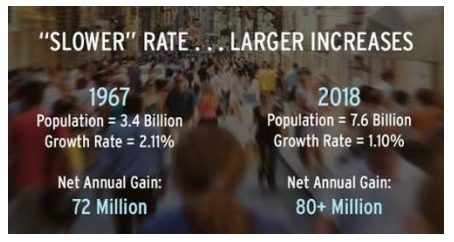It took 200,000 years for human numbers to reach one billion, in about 1800. The last billion took eleven years. It is now (Jan. 2023) 8 billion. The current rate of increase of about a billion every eleven years is the highest it has ever been. The earth could support a population of two to three billion if we all lived at the standard of the present developed world.
Humans and their animals now account for about 99% by mass of land vertebrates: only about 1% by mass are wild. The number of wild animals has more than halved since 1970: in the same period, human numbers have more than doubled. Current species extinction rates are between 1000 and 10,000 times the natural background rate.
About 50% of land surface is already modified to meet human need. Most of the remainder is icecap, taiga, desert, mountain or rain forest.
Population pressure can lead to civil unrest, wars over resources, migration on a large scale and famine. Conflict over land and water is already occurring. We need to increase food production by at least 70% by 2050. This, however, will be in the face of desertification and degradation of agricultural land, rising sea levels, over-fished oceans, acidification of seawater and unpredictable weather as the result of climate change. Agriculture is heavily dependent on oil, a fossil fuel, the use of which must be restrained if we are to have a chance. There is already widespread water scarcity: this will increase dramatically. The level of pollution resulting from our numbers and our consumption is already a danger to life, both to us and to such of wildlife as survives.
‘Overshoot Day’, the day on which the year’s supply of renewable resources for that year are exhausted, advances every year.
Suggested solutions to the food problem include eating insects and protein extracted from sewage.
On the other hand, reduction of fertility rates is achievable, given political will. Several countries have achieved dramatic falls of fertility entirely without coercion.
There is absolutely no reason why the problem should not be confronted, and every reason why it should. The ultimate aim is for mankind to be living sustainably in harmony with other species on our planet. “One element is present at all of the Climate issues today – the human race.” ( David Attenborough) When we consider living sustainably, we must include the population problem.
We already have the means to do this: we don’t have to reinvent anything.
For Evidence for the Case and a fuller explanation, see here

